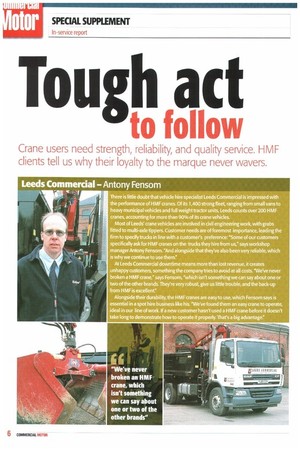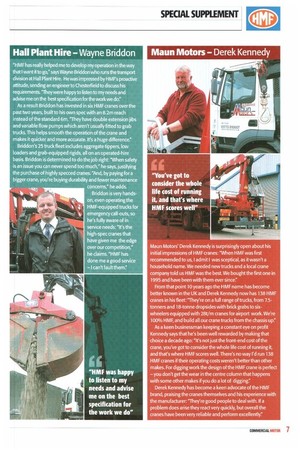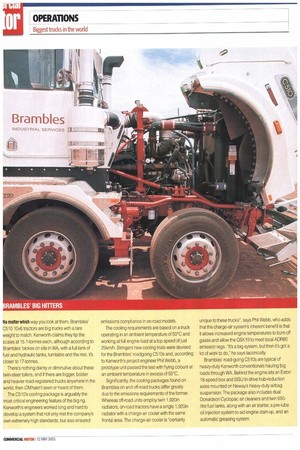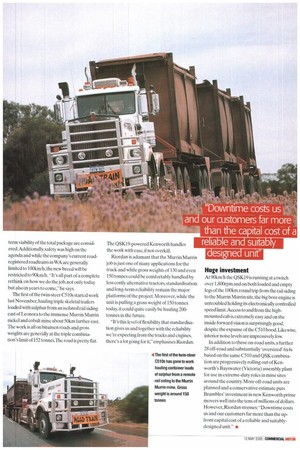Tougp o ! fili3 Crane users need strength, reliability , and quali - y service. H VF
Page 64

Page 65

Page 67

Page 68

Page 69

If you've noticed an error in this article please click here to report it so we can fix it.
clients tell us why their loyal-y to the marque never wavers.
Leeds Commercial Antony Fensom There is little doubt that vehicle hire specialist Leeds Commercial is impressed with the performance of HMF cranes. Of its 1,400 strong fleet, ranging from small vans to heavy municipal vehicles and full weight tractor units, Leeds counts over 200 HMF cranes, accounting for more than 90% of its crane vehicles.
Most of Leeds' crane vehicles are involved in civil engineering work, with grabs fitted to multi-axle tippers. Customer needs are of foremost importance, leading the firm to specify trucks in line with a customer's preference: "Some of our customers specifically ask for 1-I ME cranes on the trucks they hire from us," says workshop manager Antony Fensom. "And alongside that they've also been very reliable, which is why we continue to use them' At Leeds Commercial downtime means more than lost revenue, it creates unhappy customers, something the company tries to avoid at all costs. "We've never broken a HMF crane," says Fensom, "which isn't something we can say about one or two of the other brands. They're very robust, give us little trouble, and the back-up from HMF is excellent!'
Alongside their durability, the HMF cranes are easy to use, which Fensom says is essential in a spot hire business like his. "We've found them an easy crane to operate, ideal in our line of work. If a new customer hasn't used a HMF crane before it doesn't take long to demonstrate how to operate it properly. That's a big advantage!'
Hall Plant Hire Wayne Briddon
"HMF has really helped me to develop my operation in the way that I want it to go," says Wayne Briddon who runs the transport division at Hall Plant Hire. He was impressed by HMF's proactive attitude, sending an engineer to Chesterfield to discuss his requirements. "They were happy to listen to my needs and advise me on the best specification for the work we do!'
As a result Briddon has invested in six HMF cranes over the past two years, built to his own spec with an 8.2m reach instead of the standard 6m. "They have double extension jibs and variable flow pumps which aren't usually fitted to grab trucks. This helps smooth the operation of the crane and makes it quicker and more accurate. It's a huge difference."
Briddon's 25 truck fleet includes aggregate tippers, low loaders and grab-equipped rigids, all on an operated-hire basis. Briddon is determined to do the job right: "When safety is an issue you can never spend too much," he says, justifying the purchase of highly specced cranes. "And, by paying for a bigger crane, you're buying durability and fewer maintenance concerns," he adds.
Briddon is very hands N on, even operating the HMF-equipped trucks for emergency call-outs, so he's fully aware of in service needs: "It's the high-spec cranes that have given me the edge over our competition," he claims. "HMF has done me a good service — I can't fault them!'
Maun Motors Derek Kennedy
Maun Motors' Derek Kennedy is surprisingly open about his initial impressions of HMF cranes: 'When HMF was first recommended to us, I admit I was sceptical, as it wasn't a household name. We needed new trucks and a local crane company told us HMF was the best. We bought the first one in 1995 and have been with them ever since."
From that point 10 years ago the HMF name has become better known in the UK and Derek Kennedy now has 138 HMF cranes in his fleet: "They're on a full range of trucks, from 7.5tonners and 18-tonne dropsides with brick grabs to sixwheelers equipped with 28t/m cranes for airport work. We're 100% HMF, and build all our crane trucks from the chassis up:' As a keen businessman keeping a constant eye on profit Kennedy says that he's been well rewarded by making that choice a decade ago: "It's not just the front-end cost of the crane, you've got to consider the whole life cost of running it, and that's where HMF scores well. There's no way I'd run 138 HMF cranes if their operating costs weren't better than other makes. For digging work the design of the HMF crane is perfect — you don't get the wear in the centre column that happens with some other makes if you do a lot of digging!'
Derek Kennedy has become a keen advocate of the HMF brand, praising the cranes themselves and his experience with the manufacturer: "They're good people to deal with. If a problem does arise they react very quickly, but overall the cranes have been very reliable and perform excellently!' performance across a wide rev range, with more than 500 useable horses available from 1,350rpm through to 2,10Orpm, while between 1200 and 1,800rpm there's more than 2,300Nm of torque on tap, marking out the big-bore brawler as a consistently strong workhorse.
Some argue that despite its awesome performance the QSK is outshone by the top rating of its 15-litre Signature stablemate.That argument carries no weight with Riordan, not least when it comes to servicing, -With Signature we've struggled to get much beyond 5,000 hours of operation before overhaul. We simply needed to move to the next engine generation and for our work that meant the 19-litre Cummins. Uptime is everything."
With the QSK19 Riordan expects to notch up at least 20,000 hours before overhaul and doesn't hesitate to cite the experiences of other operators, particularly Bulkhaul's Kenworth C510s which are also powered by the QSK19 and are working in tierce conditions, at huge weights, in the Northern Territory's Tanami goldfields.
Life expectancy
"We've not heard anything that suggests we won't achieve the life-to-overhaul hours we're after, and that includes our own experiences with the K-series engines we're still running,says Riordan.
The downside for QSK is that it's a beefy lump, A 'bare bones' QSK weighs almost two-tonnes.Add a huge radiator and chargeair cooler, and all the associated plumbing and bracketry surrounding the engine, and it's easy to understand how the requirement for a twin-steer C510 developed, as legality demanded it for on-road roles.
Riordan accepts all this has meant the loss of some payload capacity, but firmly believes it's justifiable when the engine life and long No matter which ,ovay you look at them, Brambles' C510 10)(6 tractors are big trucks with a tare weight to match, Kenworth claims they tip the scales at 15.1-tonnes each, although according to Brambles' blokes on site in WA, with a full tank of fuel and hydraulic tanks, turntable and the rest, it's closer to 17-tonnes.
There's nothing dainty or diminutive about these twin-steer toilers, and if there are bigger, bolder and heavier road-registered trucks anywhere in the world, then CM hasn't seen or heard of them.
The 0510's cooling package is arguably the most critical engineering feature of the big rig. Kenworth's engineers worked long and hard to develop a system that not only met the company's own extremely high standards, but also ensured emissions compliance in on-road models.
The cooling requirements are based on a truck operating in an ambient temperature of 50°C and working at full engine load at atop speed of just 25km/h. Stringent new cooling trials were devised for the Brambles' roadgoing 0510s and, according to Kenworth's project engineer Phil Webb, a prototype unit passed the test with flying colours at an ambient temperature in excess of 55°C.
Significantly, the cooling packages found on Brambles on and off-road trucks differ greatly due to the emissions requirements of the former. Whereas off-road units employ twin 1,920in radiators, on-road tractors have a single 1,920in radiator with a charge-air cooler with the same frontal area. The charge-air cooler is "certainly unique to these trucks", says Phil Webb, who adds that the charge-air system's inherent benefit is that it allows increased engine temperatures to burn off gases and allow the QSK19 to meet local ADR80 emission regs. "It's a big system, but then it's got a lot of work to do," he says laconically.
Brambles road-going C510s are typical of heavy-duty Kenworth conventionals hauling big loads through WA. Behind the engine sits an Eaton 18-speed box and SISU tri-drive hub-reduction axles mounted on Neway's heavy-duty airbag suspension. The package also includes dual Donaldson Cyclopac air cleaners and twin 650litre fuel tanks, along with an air starter, a pre-lube oil injection system to aid engine start-up, and an automatic greasing system. term viability of the total package are considered.Additionally, safety was high on the agenda and while the company's current roadregistered roadtrains in WA arc generally limited to 100krn/h, the new breed will be restricted to 90km/h. "It's all part of a complete rethink on how we do the job, not only today but also in years to come," he says.
The first of the twin-steer C510s started work last November, hauling triple skeletal trailers loaded with sulphur from an isolated rail siding east of Leonora to the immense Murrin Muffin nickel and cobalt mine about 501an further east. The work is all on bitumen roads and gross weights are generally at the triple combination's limit of 152 tonnes.The road is pretty flat. The QSK19-powered Kenworth handles the work with ease, if not overkill.
Riordan is adamant that the Muffin Murrin job is just one of many applications for the truck and while gross weights of 130 and even 150 tonnes could be comfortably handled by less costly alternative tractors, standardisation and long-term reliability remain the major platforms of the project. Moreover, while the unit is pulling a gross weight of 150 tonnes today. it could quite easily be hauling 200tonnes in the future.
"It's this level of flexibility that standardisation gives us and together with the reliability we're expecting from the trucks and engines, there's a lot going for it," emphasises Riordan.
Huge investment
At 90km/h the QSK19 is running at a twitch over 1,800rpm and on both loaded and empty legs of the 100km round trip from the rail siding to the Murrin Murrin site, the big bore engine is untroubled holding its electronically controlled speed limit. Access to and from the highmounted cab is extremely easy and on the inside forward vision is surprisingly good. despite the expanse of the C510 hood. Likewise, interior noise levels are impressively low.
In addition to these on-road units, a further 28 off-road and substantially 'oversized' 6x4s based on the same C510 and QSK combination are progressively rolling out of Kenworth's Bayswater (Victoria) assembly plant for use in extreme-duty roles in mine sites around the country. More off-road units are planned and a conservative estimate puts Brambles' investment in new Kenworth prime movers well into the tens of millions of dollars. However, Riordan stresses: "Downtime costs us and our customers far more than the upfront capital cost of a reliable and suitablydesigned unit." sr
























































































































































































































